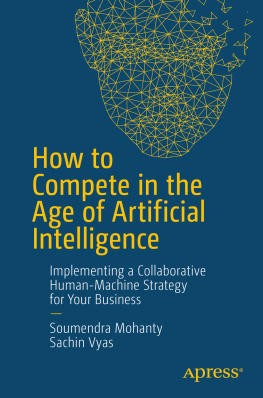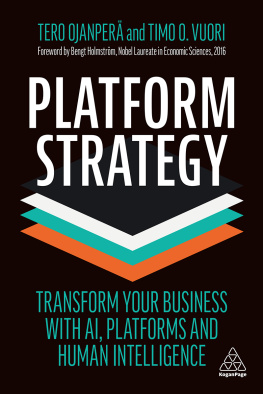Over the last several years, as we met with hundreds of CxOs, senior executives, business function owners, technology leaders, and practitioners, we realized that there are fundamental questions that everybody was trying to make some sense of:
This book is collection of thoughts, assimilating ideas, and viewssome thought provoking, some mundaneaddressing several aspects of how to compete in the age of artificial intelligence. Once you start reading the book, you will realize that the chapters are written in a blogish manner, which is precisely by design. This is to give you free-flowing thought and help you generate your own ideas.
With the short preamble out of the way, lets get started.
The original AI-powered Watson supercomputer that conquered the contestants on the Jeopardy television game show was about the size of a bedroom, with 10 odd rack-like machines forming the four walls. Todays intelligent machines are very different. They no longer exist solely within bedroom sized rooms, but are cloudified and run several 100 instances of AI services at once. The outputs are consumed simultaneously by recipients all over the world, through multiple channelssmart assistants, smart phones, smart devices, smart appliances, smart vehicles, smart utilities, smart plants, smart factories, smart buildings, smart homes, etc. The result? We are living in a world of always-on intelligence.
This pervasiveness of AI is triggering another interesting phenomenonthe more we use it, the smarter it becomes. Anything it learns in one interaction gets immediately transferred to the other interactions. AI is not one large monolithic program. It is actually a combination of diverse sets of artificial narrow agents (ANIs), each specialized to do a particular task and with capabilities like conversational interface, image recognition, voice recognition, text-to-speech, speech-to-text, logic-deduction, natural language parsing, natural language generation, knowledge base, self-learning, and adaptive engines.
Slowly and steadily, a picture of the AI future is emerging. The AI on the horizon looks more like AI as a service embedded into everything, and almost invisible. A century ago, we transformed everything to be powered by electricity to augment human capabilities; going forward we are at a similar tipping point, where we will AI-fy everything to augment human capabilities and in some cases introduce autonomous AI to eliminate human tasks altogether. Thanks to technologies like Cloud, GPU, Big Data, Blockchain, IoT, ML and DL, the process of AI-fying will become simpler in the coming days, transforming everything by infusing it with AI. In fact, dont get surprised if the business plans of the companies going forward are going to take X and add AI.
Take the example of Google. Every time we type a query or click on a link, we are becoming an active participant in training the Google AI. Starting from how to date to how to conceive to how to raise children to DIY scientific experiments to how to manage relationships to how to prepare an effective resume to what are the most asked interview questions and corresponding answers, with each of the queries we are feeding into Googles search engine, we are helping Google AI record our behavior. This includes what we think, what we want to know, when we seek information, why we are seeking information, how we use that information, and so on. Perhaps in 10 years, Googles main product will be Mind as a Service and you will be able to rent the mind of a CEO, developer, or scientist.
This is the point where things become sketchy. Ethical policies and associated debates come into play.
What is propelling this massive growth of AI? Three technology breakthroughs acted as catalysts:
Massively parallel computation: Thinking, which is the process of reasoning about something, is a massively parallel process where billions of neurons in our brain act simultaneously, passing signals to other neurons through layers of networks. The final outcome is judgment. We were handicapped to perform massively parallel processing until the graphics processing unit (GPU) was invented. The GPU unlocked new possibilities, where neural networks (loosely based on the way neurons work in our brain) can facilitate hundreds of millions of connections between the nodes, almost at a sub-second processing time.
Big Data: The intelligence that we claim is ours is taught to us over time. When the human brain sees something its never seen before, it takes time to deduce what the image is! The same rule applies to AI. Thanks to digitization and proliferation of smart phones, we have access to massive amounts of real-world data. Our ability to collect, clean, standardize, and store this real-world data provides us with an enormous training ground for AI. The result? We are beginning to see intelligence infused into almost everything, consequently transforming everything into a smart thing.








